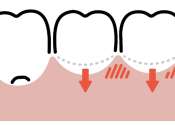Stem cells grow fully functional new teeth
(Medical Xpress) -- Researchers from Japan recently published a paper in PLoS One describing their successful growth and transplantation of new teeth created from the stem cells of mice.
(Medical Xpress) -- Researchers from Japan recently published a paper in PLoS One describing their successful growth and transplantation of new teeth created from the stem cells of mice.

Taking good care of your teeth may be linked to better brain health, according to a study published in the July 5, 2023, online issue of Neurology. The study found that gum disease and tooth loss were linked to brain shrinkage ...
Jul 5, 2023
0
206

The tissue area that surrounds our teeth is known as the gingiva, and healthy teeth will nestle firmly into the gums thanks to the many gingival fibers that connect the tooth to the gingiva. The gingiva is home to fibroblasts—cells ...
Mar 10, 2023
0
540

Tooth decay has forced unpleasant dental visits on most of the U.S. population. In fact, over 90% of adults have had at least one cavity. Furthermore, longer lifespans and egregious dental health disparities are contributing ...
Dec 21, 2022
0
60

Research led by the University of Kent has discovered evidence of a biorhythm in human primary teeth that is associated with weight gain during adolescence.
Aug 22, 2022
0
51

The first thing people notice when they meet you is your smile. To be more confident when giving wide-mouthed, eye-crinkling smiles, people want healthy, pearly white teeth. But toothpastes only remove surface stains, and ...
Aug 3, 2022
0
126

Loss of permanent teeth is usually caused by dental diseases or trauma and is common in the global population, especially among the elderly due to aging and relatively poorer oral health.
Jul 18, 2022
0
74

You and your dentist have a lot of tools and techniques for stopping cavities, but detecting the specific chemical conditions that can lead to cavities and then preventing them from ever getting started is much harder. Now, ...
Mar 8, 2022
0
92

A 38-year-old male patient complaining of difficulty breathing through one of his nostrils for several years was found to have an ectopic tooth growing in his nose. In their paper published in The New England Journal of Medicine ...

When we speak, although we may not be aware of it, we use our auditory and somatosensory systems to monitor the results of the movements of our tongue or lips.
Aug 3, 2021
0
126

Teeth (singular tooth) are small whitish structures found in the jaws (or mouths) of many vertebrates that are used to tear, scrape, and chew food. Some animals, particularly carnivores, also use teeth for hunting or defense. The roots of teeth are covered by gums. Teeth are not made of bone, but rather of tissues of varying density and hardness.
Teeth are among the most distinctive (and long-lasting) features of mammal species. Paleontologists use teeth to identify fossil species and determine their relationships. The shape of the animal's teeth are related to its diet. For example, plant matter is hard to digest, so herbivores have many molars for chewing. Carnivores, on the other hand, need canines to kill prey and to tear meat.
Mammals are diphyodont, meaning that they develop two sets of teeth. In humans, the first set (the "baby," "milk," "primary" or "deciduous" set) normally starts to appear at about six months of age, although some babies are born with one or more visible teeth, known as neonatal teeth. Normal tooth eruption at about six months is known as teething and can be painful.
Some animals develop only one set of teeth (monophyodont) while others develop many sets (polyphyodont). Sharks, for example, grow a new set of teeth every two weeks to replace worn teeth. Rodent incisors grow and wear away continually through gnawing, maintaining relatively constant length. Many rodents such as voles (but not mice) and guinea pigs, as well as rabbits, have continuously growing molars in addition to incisors.
This text uses material from Wikipedia, licensed under CC BY-SA